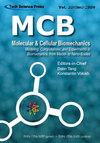The Effect of Short-Term Exposure in PM0.1 on Cardiac Remodeling and Dysfunction in Myocardial Infraction Mice
Q4 Biochemistry, Genetics and Molecular Biology
引用次数: 1
Abstract
We aimed to illustrate the association between short-term exposure PM0.1 and heart failure in myocardial infarction (MI) mice. Six-week-old ICR mice were divided into three groups randomly: sham group, MI group and MI exposure group, 12 mice in each group. LAD ligation operation was performed in MI group and MI exposure group. After postoperative two weeks MI exposure mice were put into ventilation chamber which filled with 500ug/m3 PM0.1 for 6 hours per day, while MI group mice and sham group mice were cultivated in normal environment. After exposure 8 weeks, we use Vevo 2100 machine to acquire heart function measurements. Then we collected blood sample and killed mice to obtain heart samples. The proliferation of myocardium were measured by immunofluorescence. Elisa was performed to detect the catecholamine expression in plasma. The changes of collagen were measured by Sirus red stain method. Compared with the sham group, the EF and FS in the MI group were significantly decreased (p<0.05), and MI exposure group showed higher amplitude decrease. The immunofluorescence result showed that the number of proliferating cell in MI exposure group did not change significantly. In addition, the IL-11 in the peripheral blood of MI exposure group did not change significantly, while Sirus red stain showed the content of collagen in MI exposure group increased significantly (p<0.05). In conclusion, short-term exposure in PM0.1 can exacerbate cardiac remodeling and dysfunction, while it had effect neither on IL-11 in peripheral blood nor on myocyte proliferation.短期暴露于PM0.1对心肌梗死小鼠心脏重塑和功能障碍的影响
我们旨在阐明短期暴露于PM0.1与心肌梗死(MI)小鼠心力衰竭之间的关系。将6周龄ICR小鼠随机分为假手术组、心肌梗死组和心肌梗死暴露组,每组12只。心肌梗死组和心肌暴露组分别行LAD结扎手术。术后两周后,将心肌梗死暴露小鼠置于充满500ug/m3 PM0.1的通风室内,每天6小时,心肌梗死组小鼠和假手术组小鼠在正常环境中培养。暴露8周后,我们使用Vevo 2100仪器测量心功能。然后我们采集血液样本并杀死老鼠以获得心脏样本。免疫荧光法检测心肌细胞增殖情况。Elisa法检测血浆中儿茶酚胺的表达。用Sirus红染色法测定胶原蛋白的变化。与假手术组比较,心肌梗死组EF、FS显著降低(p<0.05),心肌梗死暴露组下降幅度更高。免疫荧光结果显示,心肌梗死暴露组细胞增殖数量无明显变化。此外,心肌梗死暴露组外周血IL-11无明显变化,Sirus红染色显示心肌梗死暴露组胶原蛋白含量显著升高(p<0.05)。综上所述,短期暴露于PM0.1可加重心脏重构和功能障碍,但对外周血IL-11和心肌细胞增殖均无影响。
本文章由计算机程序翻译,如有差异,请以英文原文为准。
求助全文
约1分钟内获得全文
求助全文
来源期刊

Molecular & Cellular Biomechanics
CELL BIOLOGYENGINEERING, BIOMEDICAL&-ENGINEERING, BIOMEDICAL
CiteScore
1.70
自引率
0.00%
发文量
21
期刊介绍:
The field of biomechanics concerns with motion, deformation, and forces in biological systems. With the explosive progress in molecular biology, genomic engineering, bioimaging, and nanotechnology, there will be an ever-increasing generation of knowledge and information concerning the mechanobiology of genes, proteins, cells, tissues, and organs. Such information will bring new diagnostic tools, new therapeutic approaches, and new knowledge on ourselves and our interactions with our environment. It becomes apparent that biomechanics focusing on molecules, cells as well as tissues and organs is an important aspect of modern biomedical sciences. The aims of this journal are to facilitate the studies of the mechanics of biomolecules (including proteins, genes, cytoskeletons, etc.), cells (and their interactions with extracellular matrix), tissues and organs, the development of relevant advanced mathematical methods, and the discovery of biological secrets. As science concerns only with relative truth, we seek ideas that are state-of-the-art, which may be controversial, but stimulate and promote new ideas, new techniques, and new applications.
 求助内容:
求助内容: 应助结果提醒方式:
应助结果提醒方式:


